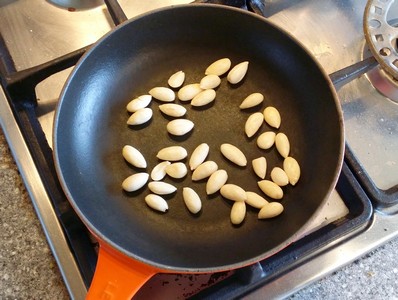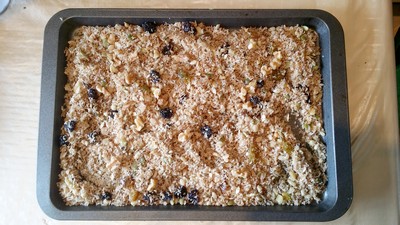
Panjeeri, a traditional healing food for new mums from my South Asian culture. Panjeeri is nutrient-dense and packed with therapeutic spices.
If you have been following my blogs you will have noticed that I like to integrate the positive aspects of health and healing from my South Asian heritage with naturopathic and nutritional knowledge.
Let me give you an example of this, my husband’s nephew has a new addition to his family, a beautiful baby girl. Here I am holding her, doesn’t she look cute?
Anyway, whilst I cuddled her, I thought about my ancestral ways for supporting both mother and baby. Baby massage and panjeeri for mum came to mind.
Modern day living has in the main resulted in a decline of traditional recipes, experience and know-how. This wealth of knowledge was usually passed down each generation by the family elders. Pre-conception health, pregnancy, childbirth, breastfeeding etc are areas where there has been a loss of this type of traditional knowledge. It is crucial for the health of mother and baby to nurture each stage correctly. Many traditional cultures developed therapeutic recipes for expectant mothers, which stimulated healing and promoted the flow of breast milk. These healing foods also helped to prevent issues like low energy and post-natal depression.
My mum is a real treasure trove for these traditional healing foods. We talked about our family recipe for panjeeri, which is North Indian dish for new mothers but has its origins in Ayurvedic medicine. Panjeeri is traditionally an energising and warming food. It helps to promote circulatory and lymphatic flow. Panjeeri also helps to clear the uterus and excess fluid from the mother’s body after birth.
After doing some research online and comparing my family recipe for panjeeri, I discovered that there are so many variations for panjeeri. Each family has added their own unique interpretation and blend of spices. You can even find ready-made panjeeri in some shops but this version is eaten as a sweet snack and does not contain the traditional therapeutic spices.
What’s Panjeeri Made Of?
Panjeeri varies from region and may come in the form of the dry muesli-style mix of spices, nuts, seeds and dried fruits, which is traditionally consumed with milk. There is also a softer halva-style of panjeeri with a consistency somewhat like mashed potato and a more solid style which may be shaped into balls or cut into slices like an energy-bar.
Traditionally panjeeri has a base of whole wheat flour and/or semolina cooked in clarified butter. Rice flour, desiccated coconut or coconut flour may also be included in the base or they could completely replace wheat flour. To this base, gum Arabica and therapeutic spices like fennel seeds and ginger are mixed in. A range of nuts like almonds, cashews etc and seeds like pumpkin, puffed lotus seeds and melon are added. Dried fruits like raisins, dates and unrefined cane sugar (jaggery) are also added to sweeten the panjeeri.
Analysing the ingredients, you will understand why this food would be beneficial to new mothers.
Range of ingredients found in Panjeeri Recipes
- Gum Arabic (Helps uterus contract, warming, source of fibre, pre-biotic)
- Flame of the forest (kamarkas, promotes healing of muscles, stimulates uterus)
- Turmeric powder (Anti-inflammatory, clears liver/blood, antifungal, antibacterial)
- Ginger powder (Promotes circulation, warming, clears liver, antiseptic)
- Ground Fennel seeds (Anti-spasmodic, warming, antiseptic, promotes milk flow)
- Ground Ajova seeds (Anti-spasmodic, warming, antiseptic, promotes bile flow)
- Ground Cumin seeds (Anti-spasmodic, cooling, antiseptic, promotes bile flow)
- Ground Cardamom seeds (Anti-spasmodic, warming, antiseptic)
- Pumpkin/Melon seeds (Protein, essential fatty acids, minerals)
- Lotus seeds (Protein, essential fatty acids, minerals)
- Almonds, pistachios, cashews (Protein, essential fatty acids, minerals)
- Dates, raisins, apricots (Fibre, laxative, minerals)
- Jaggery (unrefined sugar, warming, helps clear mucous, minerals)
- Ghee (Clarified Butter, fat soluble vitamins)
- Coconut Oil (Medium chain fatty acids)
- Dried Coconut (Medium chain fatty acids, fibre)
- Whole Wheat Flour/semolina (Fibre, protein, potassium, B-vitamins, vitamin E)
Personally, I feel that any recipe for a therapeutic panjeeri needs to be adapted to the ndividual health needs of the person. With my new mum in mind, I developed a recipe especially for her.
Coconut Panjeeri
I’m creating a gluten-free base for a dry-muesli style of panjeeri using desiccated coconut. Coconut has so many benefits but best of all it contains lauric acid which is anti-fungal, anti-bacterial and helps provide energy easily to the body. To this base I will be adding gum Arabic, flame-of-the- forest which support the muscles and in particular the uterus. Ginger supports circulation and lymphatic flow, whilst ginger, fennel and cardamom help prevent digestive spasms. Fennel helps to promote milk flow and supports breast feeding.
I am also going to put in a lot less fat and sugar compared with traditional recipes. So instead of frying nuts and seeds in oil, I am going to pre-soak and then dry roast them at a low heat. This helps make the nuts and seeds more digestible. I will add unrefined sugar right at the end when everything has been blended in. In this way I will end up hopefully adding a lot less!
Ingredients
1.5 cups desiccated coconut
1/4 cup coconut oil
1/4 cup gum Arabica
1/4 cup almonds
1/4 cup melon seeds
1/4 cup mixed seeds (pumpkin, sunflower & pine nuts)
1/4 cup raisins
1 tbsp flame-of- the-forest (kamarkas)
1 tbsp fennel seeds
1/2 tsp cardamom seeds
1 tsp ginger powder
Method
- First I pre-soaked my nuts and seeds for a couple of hours (almonds, melon seeds, pumpkin seeds, sunflower seeds and pine nuts). Soaking helps to switch off anti-nutrients and makes them easier to digest.

- After soaking I drained the nuts/seeds off and peeled off the skins on the almonds. The skins contain most of the phytates found in almonds, which prevent mineral absorbtion.
- I then set my oven to the lowest temperature around 60oC and dry-fried the drained nuts/seeds separately in my cast iron skillet. This helped to quickly dry them.

- The dry-fried nuts and seeds were then laid in a baking tray and dried further in the oven for around an hour.

- Next on a gentle heat, I dry-fried the fennel and cardamom seeds. This helps them to release essential oils. I ground up the fennel/cardamom mix into a powder and put it into a glass jar.

- Then I melted the coconut oil in my skillet until it was hot enough to fry the gun Arabic. You know when the oil is hot enough, the crystals puff up and become crisp.
This is what gum Arabic looks like before frying.
and this is what it looks like after frying
- I removed the fried gum Arabic and then fried the flame-of-the-forest (kamarkas) in the same oil for a few minutes.

- After removing the fried flame-of- the-forest there wasn’t much coconut oil left in my skillet so I wiped it clean and added a couple of tablespoons of coconut oil and the desiccated coconut. I gently fried this until the coconut was nicely toasted and had browned.

- Next I added 2 teaspoons of the ground fennel/cardamom mixture and a teaspoon of dried ginger to the toasted coconut. I had a quick taste to check the spices and then I switched off the heat at this stage.

- In my coffee grinder, I ground up the fried flame-of-the-forest. I prefer the flame-of-the-forest to be finely ground otherwise it has a gritty feel. This ground up mixture was then mixed into the coconut mixture.

- Next I mixed in the dried raisins.

- By now the nuts and seeds had been drying in the oven for at least an hour. I took them out and in my chopper roughly chopped the almonds with the fried gum Arabic. I mixed this into the coconut mixture.

- Finally I mixed in the dried seeds (melon, pumpkin) and pine nuts

The panjeeri tasted quite good to me at this stage but I think it’s personal preference whether you want to leave it like this or add some unrefined sugar (jaggery) to sweeten it up. Traditionally panjeeri mixes are a lot sweeter, so I let my panjeeri cool down in a tray before adding a couple of table spoons of powdered jaggery to it.
Here it is my coconut panjeeri, an energising snack which may be eaten on its own or sprinkled onto yoghurt or mixed into porridge or smoothies.
